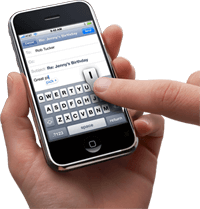
Why is the iPhone truly a mini-revolution?
 When I bought my first cell phone in 1992, I already felt I was becoming part of a mini-revolution. The freedom of being able to communicate at any time of the day or night and from anywhere changed my life, as well as the life of many others.
When I bought my first cell phone in 1992, I already felt I was becoming part of a mini-revolution. The freedom of being able to communicate at any time of the day or night and from anywhere changed my life, as well as the life of many others.
Because cell phones now offer increased capabilities, all sorts of new functions are being integrated into them: camera, web browser, email client, games, etc. However, the successful integration of these functions has come up against more than a few barriers. Without necessarily preventing usage, some of these functions have not been so well received by certain user groups. For example, text messaging has not been as widely adopted by business people as it has by youth who are addicted to this service.
The large majority of these barriers are linked to two of the most basic aspects of any electronic product: how information comes in and how it gets out. Cell phones have always been extremely limited when it comes to these two points and not much has been done to find solutions.
The cell phone’s keyboard was designed to dial numbers, not write text. The skill required to write a simple text message is quite difficult to master despite the dexterity with which young people can use their thumbs. Using email on a cell phone is only possible for those with a lot of patience and time to waste. It can also be quite difficult to navigate menus because of the size and layout of the keys. Basically, the whole thing is just not very user friendly and certainly not very intuitive.
The small size of the cell phone’s screen makes it difficult to read, limits the number of characters displayed and makes the use of advanced applications virtually impossible.
Some companies like RIM have tried to propose solutions to these problems with products like the BlackBerry. Those who have used a Blackberry know that it’s a significant improvement but not a revolutionary one. This product has especially improved how we receive emails without really making it easier to send them.
The way that the iPhone proposes to break down those barriers is what truly makes it a revolutionary product.
 The iPhone has a big enough, high-resolution screen and a keyboard that adapts to the specific function being used and, the ultimate invention is that it’s all done by touchscreen.
The iPhone has a big enough, high-resolution screen and a keyboard that adapts to the specific function being used and, the ultimate invention is that it’s all done by touchscreen.
These solutions make the product pleasant and intuitive to use, without taking away from the benefits of the original 1992 revolution: freedom and portability
Finally, a concept and design that allows us to go beyond our limits and opens the door to new ideas and new interactive models in a way that was, until now, unheard of.
At this stage, it’s hard to say whether or not these solutions were properly implemented; we’ll have to wait until iPhone comes to Canada for a more detailed analysis. However, initial feedback indicates that Apple has kept its end of the bargain.
Photos: Apple Inc.
0 Comment(s)